Ankit Raj
Head of Growth at Rise In
February 17, 2025
Neon EVM: Your Gateway to Building Ethereum DApps on Solana
Unleash the Power of Solana's Speed and Scalability for Your Ethereum Projects
.png)
We would like to introduce you to the First EVM on the Solana blockchain.

Want to develop on Solana but are you an Ethereum developer? You are in the right place. I would like to introduce you to the first EVM on the Solana blockchain.
What is Neon EVM?
Neon EVM is an Ethereum Virtual Machine (EVM) empowering developers to build and deploy dApps seamlessly from EVM chains to Solana, all from their existing codebase.
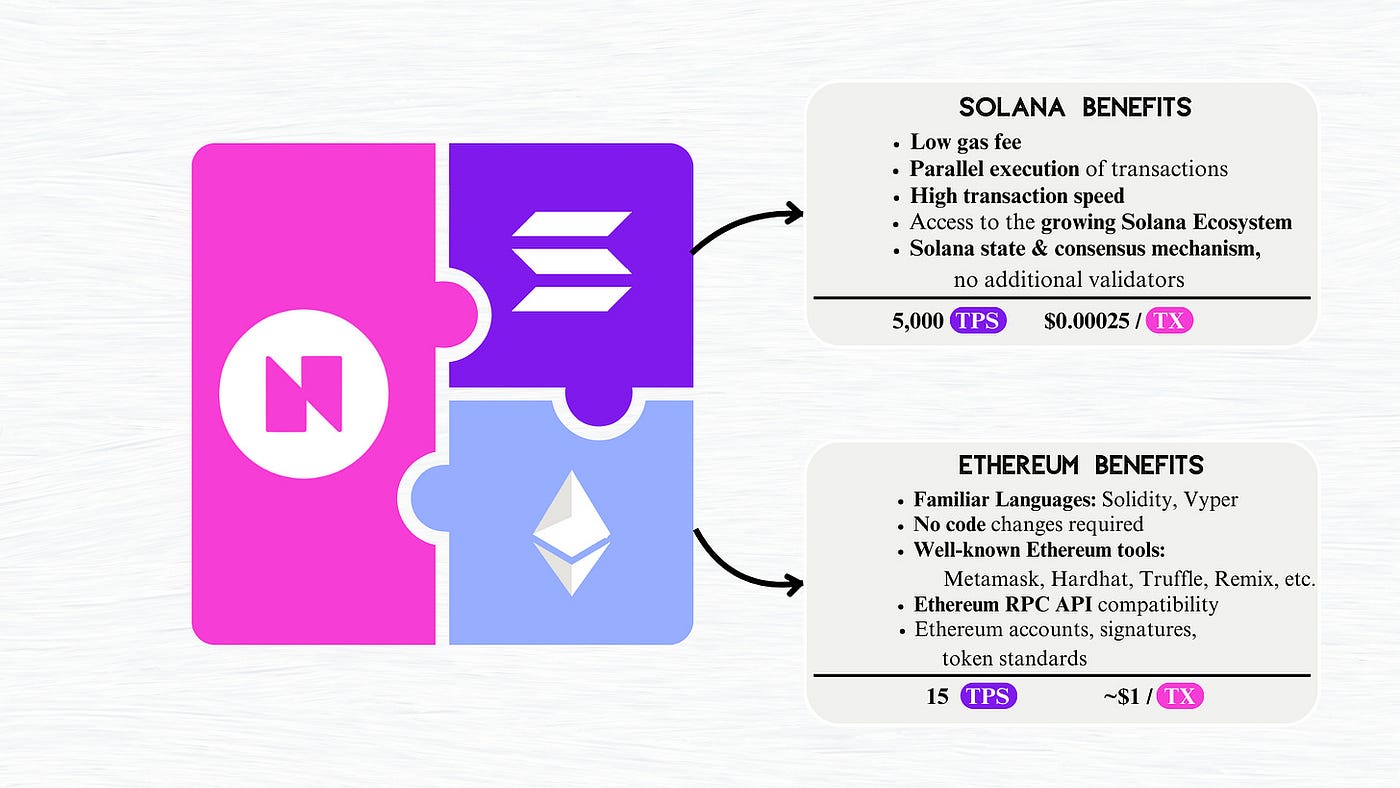
Neon EVM provides a seamless solution for Ethereum dApps to operate within the Solana ecosystem, effectively bridging the gap between these two prominent blockchains. Neon EVM positions Ethereum developers to harness the full potential of Solana’s network, benefiting from its low fees, high transaction speeds, and parallel transaction execution capabilities.
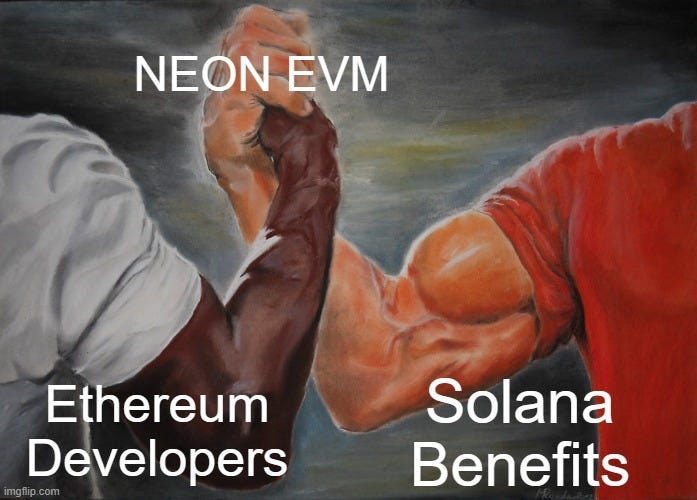
Let’s take a look at how Neon EVM works.
NEON EVM Work Mechanism
Effecting a user-initiated transaction (tx) from an Ethereum dApp on Solana requires three main steps:
- The user initiates a tx. A tx is a signed Ethereum-like tx directed to a Neon RPC endpoint.
- This request is received by the Neon Proxy.
2.1 The Neon Proxy processes the request, providing:
- Gas usage estimate for tx execution
- Broadcast initiation: wrapping the Ethereum-like tx as a Solana tx
2.2. The Neon Proxy passes the wrapped tx to the Neon EVM program hosted on Solana. This results in the following:
- A Solana receipt
- A corresponding Neon EVM receipt
2.3 The Neon smart contract then:
- Unwraps the tx and checks the user’s signature
- Loads the EVM state, including account data and the smart contract’s code, from Solana storage
- Executes the tx inside Solana BPF
- Updates Solana’s state to reflect the new Neon EVM state
3. Solana and Neon EVM undertake a state change.
This completes the tx request.
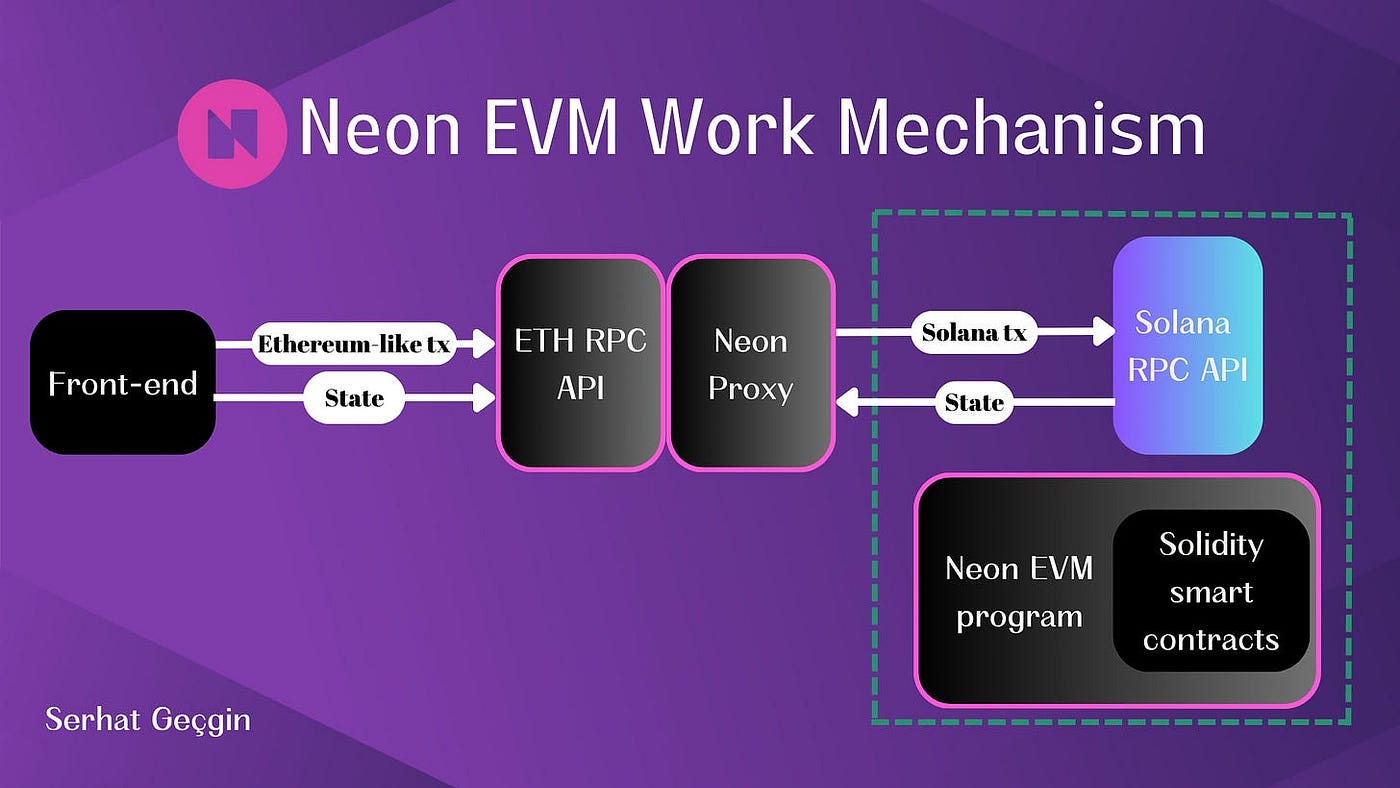
While we are in this area, I would like to give you information about Neon EVM’s token.
Neon Token
The NEON token serves as the intrinsic token of the Neon EVM, playing a dual role as both a utility and governance token:
- Utility Token: Functioning as the primary means of payment for user transactions, including transfers, deployment of dApps, and interaction with dApps on the Neon platform. This mirrors the role of ETH on the Ethereum network, establishing NEON as the go-to currency for various actions within the Neon EVM ecosystem.
- Governance Token: Empowering token holders with the right to vote within the Neon DAO for decentralized community governance. As a governance token, NEON allows community members to actively participate in decision-making processes, ensuring a democratic and inclusive approach to the platform’s development and evolution.
1- Token Utility Aspect: The Neon token plays a pivotal role in facilitating all financial transactions within the Neon EVM ecosystem, encompassing the fees owed to Neon operators.
In the transaction execution process within Neon EVM, when a Neon user, representing an end-user of a dApp integrated with the Neon EVM, initiates a transaction, they submit a transaction request to a designated Neon operator. These operators bear dual responsibilities:
- Transaction Wrapping: The crucial task of encapsulating the Neon transaction into a Solana transaction, enabling its iterative execution across a Solana cluster.
- Execution Payment: Bearing the financial responsibility for the execution of each iteration of the Neon transaction.
The primary objective of this abstraction is to enhance the overall user experience by streamlining the payment process associated with Neon transactions. For every iteration of a Neon transaction, the Neon operator disburses SOL tokens, contributing to both the Solana Validator and the Neon DAO Treasury. This specific payment is recognized as the Neon EVM platform fee, which is vital for the sustained development of the Neon EVM ecosystem.
In reciprocity, the Neon user compensates the Neon operator using NEON tokens, covering the expenses related to the Solana validation fee, the Neon EVM platform fee, and the operator’s commission. This reciprocal payment model ensures a simplified and efficient transactional process, contributing to an enhanced user experience within the Neon EVM environment.
2 - Governance
NEON holders are able to propose changes to the Neon protocol and vote on proposals that affect the Neon protocol, using their NEON tokens as votes.
Neon Ecosystem
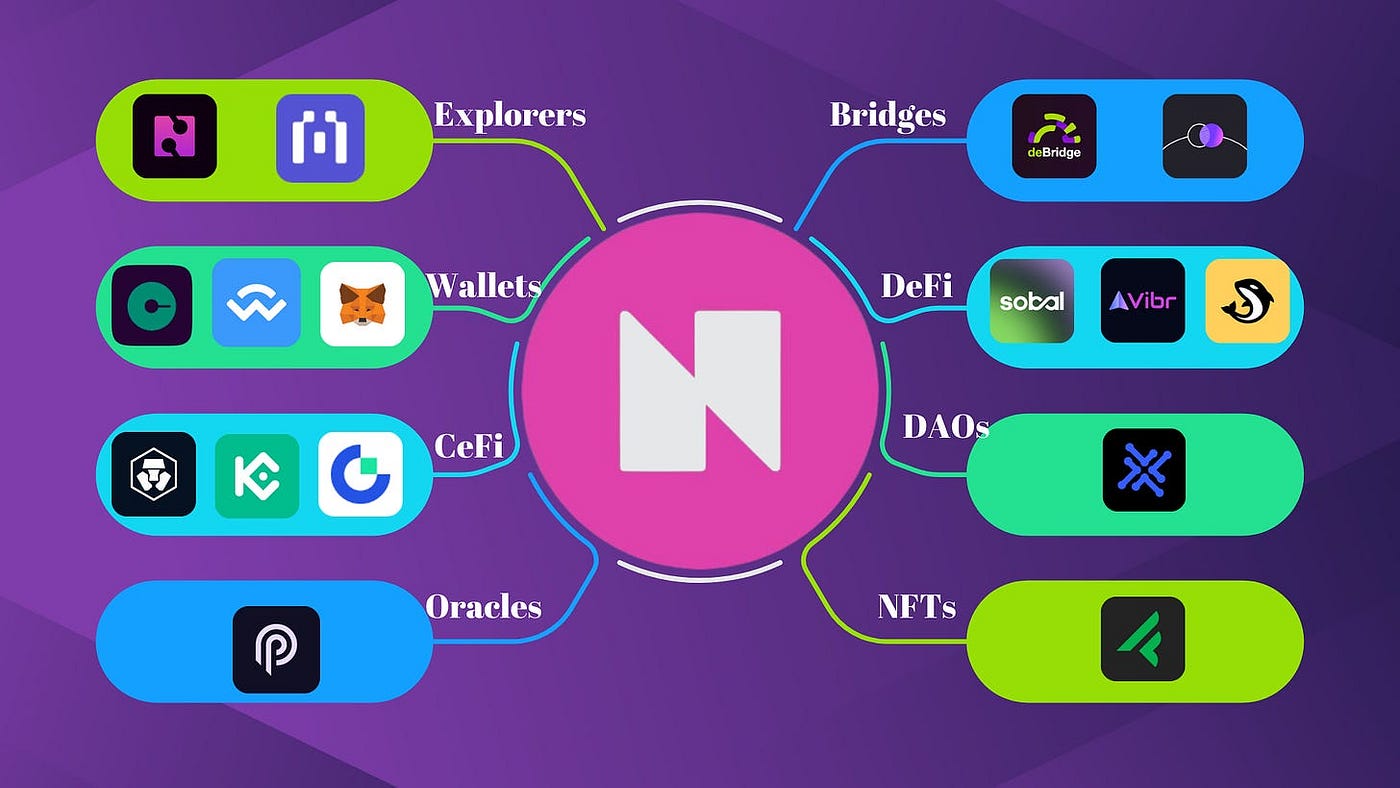
The Neon EVM ecosystem forms a dynamic landscape, comprising an array of tools, services, and initiatives tailored to provide Ethereum developers and users with a distinctive experience within the Solana blockchain. Let’s delve into a more nuanced exploration of the key components within the Neon EVM ecosystem:
- Neon Token (NEON): At the heart of the Neon EVM ecosystem lies the NEON token, serving as a fundamental element for processing user transactions, compensating Neon operators, and actively participating in the governance mechanisms inherent to the ecosystem.
- Neon Operators: Functioning as integral players, Neon operators play a pivotal role in overseeing user transactions and orchestrating the execution of Neon transactions on the Solana blockchain. Their responsibilities encompass the conversion of user transactions into Solana transactions and shouldering the associated costs, thereby forming the foundational framework of the ecosystem.
- Neon DAO (Decentralized Autonomous Organization): Embracing a decentralized governance paradigm through Neon DAO, the ecosystem champions community engagement and democratic decision-making. NEON token holders wield influence over the future trajectory of the Neon ecosystem, actively contributing to and shaping decision-making processes.
- Neon Tools: Advancing Development and Analysis Within the Neon ecosystem, a suite of tools is offered to elevate the development and analysis of applications. These tools encompass:
Block Explorer: NeonScan stands as a comprehensive block explorer and analytics platform, offering users the ability to scrutinize Neon transactions within the Solana network. This tool delivers valuable insights into transaction histories, block specifics, and other analytical data.
NeonPass: Facilitating the seamless transfer of ERC-20 tokens between Solana and the Neon EVM, NeonPass leverages the ERC-20 SPL wrapper. Users can effortlessly transfer tokens across these platforms using non-custodial wallets, enhancing the interoperability of assets.
NeonFaucet: Geared towards developers, NeonFaucet serves as a resource for NEON test tokens and other ERC-20 test tokens to be utilized in testing applications on the DevNet. This tool empowers developers to experiment and verify the smooth functionality of their applications before moving forward with deployment.
DApps and Smart Contracts: Engineered to run Ethereum-compatible smart contracts seamlessly, the Neon EVM ecosystem emerges as a fitting platform for Ethereum developers. This adaptability facilitates the seamless integration of diverse DApps and smart contracts into the vibrant Neon ecosystem.
Solana Blockchain Integration: Capitalizing on its integration with the Solana blockchain, Neon EVM leverages advantages such as low transaction fees, rapid transaction speeds, and scalability. This integration not only fortifies the Neon ecosystem but also ensures an optimized and efficient experience for its users.
Community Engagement: A hallmark of the Neon EVM ecosystem is its proactive encouragement of involvement from developers, users, and other stakeholders. This inclusive approach fosters an environment of continual growth and development within the ecosystem.
By synergizing the strengths of Solana with the expertise of Ethereum developers and the engagement of users, the Neon EVM ecosystem emerges as a trailblazing platform, poised to lead the evolution of future blockchain applications.
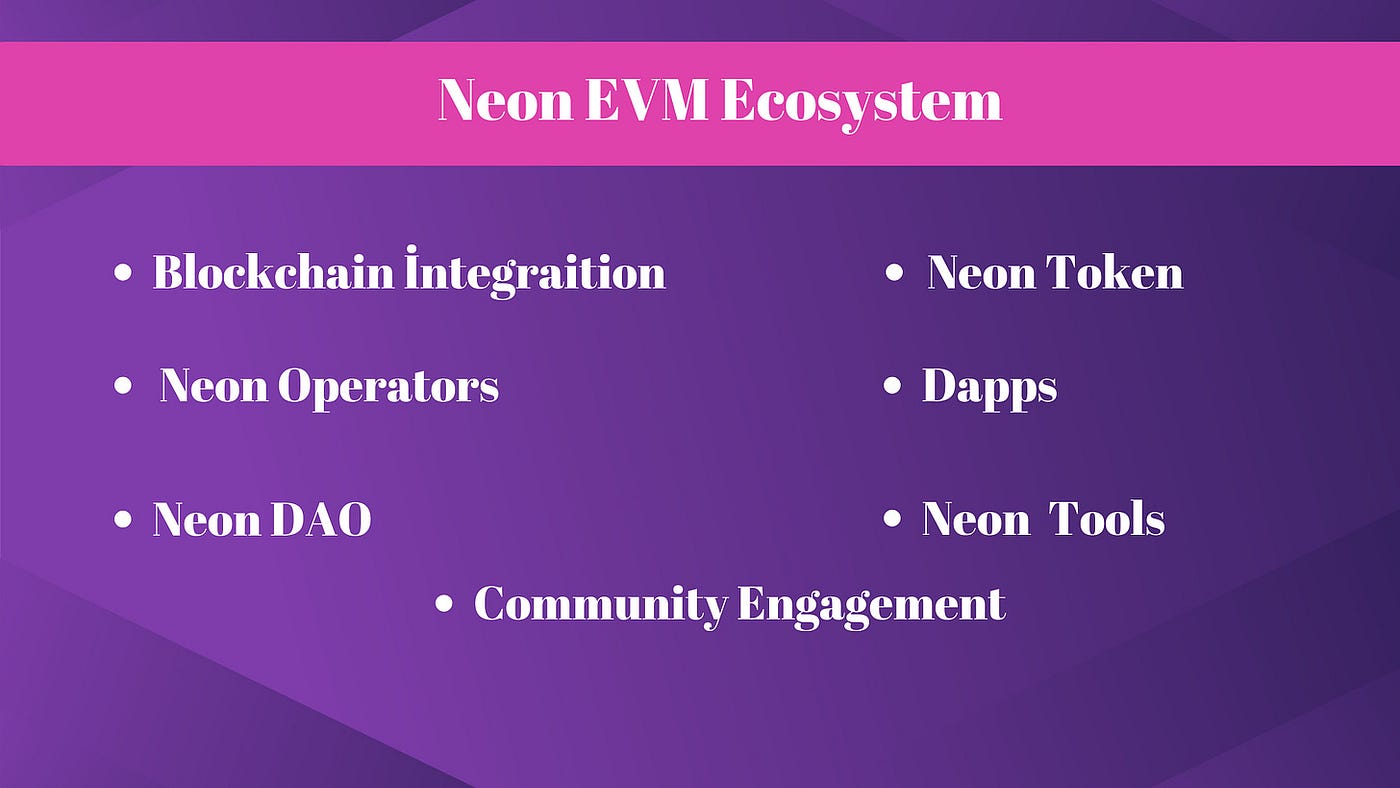
Contributions of Neon Projects to the Solana Ecosystem
The contributions of Neon projects to the Solana ecosystem can be quite significant, thanks to the unique features of Neon EVM and Ethereum compatibility. Among these contributions, the following elements may stand out:
1. Advanced Smart Contract Capabilities: Neon EVM integration with Solana can bring advanced smart contract capabilities to the Solana ecosystem. Compatibility with Ethereum’s Solidity language and Ethereum-compatible DApps working through Neon projects can become more functional on the Solana blockchain.
2. Developer Acquisition:*Neon projects may have the potential to attract Ethereum developers to the Solana ecosystem. The fact that Neon EVM offers a familiar development environment can allow new talent and ideas to develop projects on Solana, resulting in an increase in the number and diversity of projects.
3. Increased Transaction Volume: Adoption of Neon EVM can lead to increased transaction volume on the Solana blockchain. Developers and users using Neon projects can increase overall efficiency on Solana, which increases the resilience of the network and validates its scalability capabilities.
4. Cross-chain Asset Transfers: Neon EVM’s interactivity capability can facilitate cross-chain asset transfers between Neon and Solana ecosystems. This can encourage collaboration and liquidity, allowing assets to move more seamlessly between the two networks.
5. Community Growth: Joining Neon projects into the Solana ecosystem can attract a broader community interested in the unique features Neon EVM offers. This community growth can create a more vibrant and diverse Solana ecosystem.
Neon EVM Pros and Cons
Advantages:
1. Ethereum Compatibility: Neon EVM is compatible with the Ethereum virtual machine, allowing developers to seamlessly migrate existing Ethereum smart contracts to the Solana blockchain. This could attract Ethereum developers, creating a more diverse ecosystem on Solana.
2. Low Transaction Fees: Neon EVM leverages the Solana blockchain with low transaction fees. This may make Neon EVM more attractive to developers and users compared to other networks with high transaction costs.
3. High Transaction Capacity and Scalability: Solana’s high transaction capacity and scalability features enable Neon EVM to offer faster transaction processing and better scalability.
4. Developer-Friendly Tools: The Neon ecosystem offers tools such as NeonScan, NeonPass, and NeonFaucet. These tools can streamline development processes, improve user experience, and make it easier to test applications on DevNet.
5. Community-Based Governance: The integration of a decentralized autonomous organization (DAO) allows the community to actively participate in decision-making processes. This can contribute to a more democratic and community-oriented development of the Neon EVM ecosystem.
Disadvantages:
1. Limited Adoption (until late 2022): One of the challenges Neon EVM may face is competing with previously established blockchain ecosystems. The success of Neon EVM will depend on its ability to attract developers and users from other platforms.
2. Ecosystem Maturity: The Neon EVM ecosystem may still be in the early stages of development. This can result in a lack of mature projects and a smaller user base.
3. Security Concerns: Any new technology like Neon EVM may face criticism regarding security. Developers and users may be cautious due to possible security concerns for a relatively new platform for critical applications.
4. Dependency on Solana: The success of Neon EVM is associated with the success and security of the Solana blockchain. Any issues in Solana may impact Neon EVM users and developers.
Conclusion
In essence, Neon EVM represents a bridge between two prominent blockchain worlds, offering a pathway for developers and users to experience the best of both Ethereum and Solana. Its journey is marked by potential, innovation, and the continuous pursuit of a more inclusive and efficient decentralized future.
I congratulate Neon EVM for being the first project to offer EVM service in Solana. I think bringing both Solana and Ethereum developers together will provide an incredible rise. From what I have observed, it shows that the ecosystem will develop further by 2024 and will be able to provide us with many new projects. I enjoyed writing this article. I hope you enjoyed reading it too.